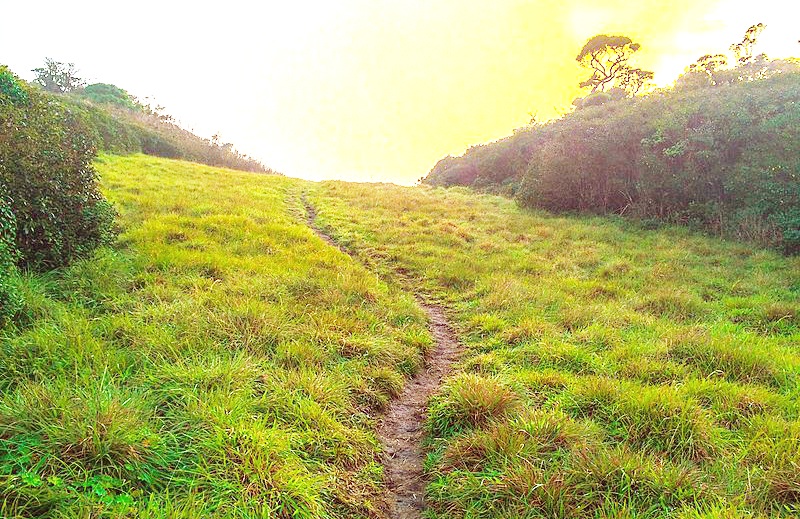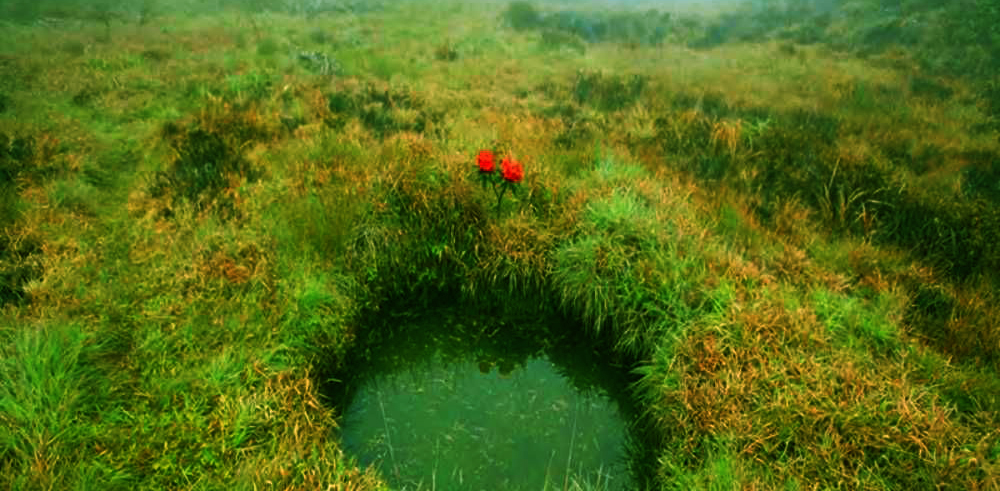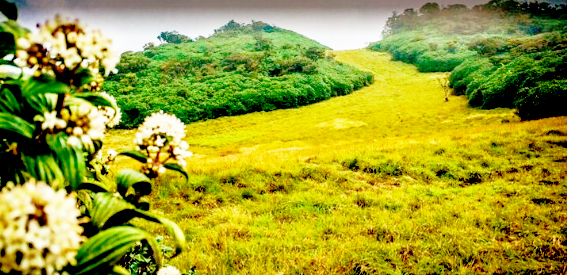Explore the Chariot Path and Sita Tear Pond in Sri Lanka, a hidden gem with legendary significance and breathtaking views.
Unveiling the Chariot Path in Sri Lanka’s Ramayana Odyssey
The Chariot Path, a pivotal feature in the Ramayana Tours of Sri Lanka, traces the legendary route where Ravana conveyed Sita Devi from Sita Kotuwa to Ashoka Vatika. This path, also dubbed the Ravana grass pathway, is nestled in the dense forests atop the Ramboda Hills along the Kandy-Nuwara Eliya main road. A testament to the epic’s lore, this barren strip, devoid of any vegetation save for grass, is believed to have been used by King Ravana to showcase the splendor of his realm to Sita Devi. The Chariot Path and Sita Tear Pond stand as monumental Ramayana landmarks in Sri Lanka.

The Enigmatic Sita Tear Pond
En route the Chariot Path, one encounters the poignant Sita Tear Pond. This small pond, formed by Sita Devi’s tears, has miraculously never dried, even during severe droughts when nearby rivers have. Perched atop a mountain range in Sri Lanka’s central highlands, it offers panoramic 360-degree vistas. The Sita Tear Pond is a site of profound significance on the Ramayana tour.

Flora of the Chariot Path Locale
The Chariot Path is characterized by its exclusive grassy expanse, a visual affirmation of the Ramayana narrative. The pathway is adorned with numerous large trees flaunting bright red blossoms, known locally as Sita Flowers. These flowers, with their unique petal, stamen, and pistil configurations resembling a human figure with a bow, are said to symbolize Rama. Remarkably, these blooms are unique to this area in Sri Lanka.
Navigating to Chariot Path and Sita Tear Pond
Accessing the Chariot Path and Sita Tear Pond requires a rugged journey, suitable only for 4WD vehicles or estate tractors. The drive to Frotoft tea estate from Labookelle spans approximately two hours. The arduous trek to the summit, challenging for children, the elderly, and the physically infirm, takes about three hours—two hours uphill and one hour down.
There are two primary routes:
1. Via Pussellawa: This preferable route involves turning left 2km from Pussellawa town on the Peradeniya-Nuwara Eliya road, followed by a 17km uphill drive.
2. Via Frotoft (through Labookelle): This route requires off-road vehicles, with the trek continuing along estate roads and jungle paths.

Time Investment for Visiting the Chariot Path
To fully appreciate this Ramayana site, allocate at least half a day. The journey includes a two-hour drive to Frotoft and a three-hour trek to the site.

Feasibility of Visiting Chariot Path and Sita Tear Pond
While a rewarding experience, this destination is challenging to reach, making it unsuitable for senior citizens or individuals with heart conditions or respiratory illnesses.
A Scenic Hiking Haven
Contrary to its name, the Chariot Path isn’t a mere path but a natural glade in Sri Lanka’s central mountains, offering breathtaking viewpoints. This idyllic hiking destination, with its well-trodden footpath through dense forest, culminates in a mountain grassland atop the ridge. The grassland, primarily composed of Arundinella villosa and Chrysopogon zeylanicus, is interspersed with Nelu trees (Strobilanthes viscosa) and rhododendrons.
Why Visit the Chariot Path?
Beloved by Sri Lankan campers, especially the youth, the Chariot Path remains a hidden gem, seldom visited by foreign travelers, thereby offering a tranquil experience. Comparable to the famed Horton Plains, it features natural grassland clearings amidst pygmy forests. Both locations offer splendid panoramic views, cool morning temperatures, and cloud-kissed landscapes, accessible via scenic routes.
However, the Chariot Path stands out for its less crowded ambiance and more authentic local interactions. The vantage points, often more spectacular than Horton Plains’ “World’s End,” provide diverse directional views from ridge-top locations. Additionally, the area boasts an abundance of Heen Bovetiya flowers, enhancing its allure. Unlike Horton Plains, no national park ticket is required, and camping is permitted, allowing visitors to savor stunning sunsets and serene early mornings.
A Rewarding Hiking Destination
Standing at an elevation of 1,970 meters (6,460 feet) above sea level, the Chariot Path is among Sri Lanka’s coldest locales. Despite higher elevations at Horton Plains and parts of Nuwara Eliya, the Chariot Path’s open terrain subjects it to stronger winds. From its grasslands, Pidurutalagala, Sri Lanka’s highest peak, is just 11 km (7 miles) away.
Journeying to the Chariot Path
The hike starts from 1,690 meters (5,544 feet) at the forest edge, meeting the uppermost fields of Frotoft tea plantation. Hikers ascend a 1.5 km (1 mile) trail, overcoming a height difference of 280 meters (920 feet). The journey begins at Frotoft Tamil Vidyalayam’s car park, 1.5 km from the jungle trailhead, and passes the Frotoft Old Hospital. From Pussellawa, a 16 km (10 miles) drive on a bumpy road leads to the Frotoft Old Hospital, taking about one and a half hours due to road conditions.
Optimal Visiting Times
Chariot Path experiences significant fog and rainfall for most of the year, especially from October to January. The driest and most recommended months for a visit are February to April. Long trousers and sleeves are advisable for protection against cold winds, intense sunlight, and scratches from shrubs and spiky grass.
Legend and Nomenclature of the Chariot Path
The Chariot Path’s grassland strips are believed to be remnants of the Pushpaka Vimana, Ravana’s flying chariot. Legend holds that Ravana brought Sita Devi here to impress her with his kingdom’s beauty. The barren patches where the chariot touched the ground have remained void of forest vegetation ever since. The Sita Tear Ponds, formed from Sita’s tears, never dry out, further enhancing the site’s mystique.
Sita Flowers
The Chariot Path is adorned with large trees bearing bright purple blooms, known as Sita Flowers. These blossoms, with stamen and pistil resembling a human figure with a bow, symbolize Rama. Although these flowers, Heen Bovitiya (Osbeckia octandra), are common in Sri Lanka’s central highlands and used in traditional Ayurvedic medicine, their unique association with the Chariot Path adds to the locale’s charm.
Practical Tips for a Memorable Visit
Health Precautions
Given the physical demands of the trek, it is advisable for visitors to assess their health conditions before embarking on the journey. Those with heart problems, respiratory issues, or other health concerns should consult with a healthcare provider to ensure it is safe for them to undertake the hike.
Sustainable Tourism Practices
To preserve the pristine environment of the Chariot Path, visitors are encouraged to practice sustainable tourism. This includes carrying out all trash, respecting local wildlife, and avoiding the disturbance of natural habitats. By adhering to these practices, travelers can help maintain the beauty and ecological integrity of this unique destination.
Chariot Path: Advantages and Disadvantages
Discovering the Chariot Path in Sri Lanka
The Chariot Path, a significant landmark in Sri Lanka’s Ramayana tours, offers an enchanting blend of mythology, natural beauty, and adventure. Nestled in the central highlands, this route is famed for its unique landscape and historical importance. Here, we delve into the advantages and disadvantages of exploring this mystical pathway.
Advantages of Visiting the Chariot Path
- Historical Significance:
- Mythical Connection: The Chariot Path is steeped in Ramayana lore, where King Ravana is said to have transported Sita Devi. This historical allure makes it a fascinating destination for those interested in ancient legends.
- Breathtaking Scenery:
- Panoramic Views: The Chariot Path offers stunning 360-degree vistas of the central highlands, making it a photographer’s paradise.
- Unique Flora: The area is home to rare flowers, such as the Sita Flowers, and diverse vegetation, enhancing its natural beauty.
- Adventure and Hiking:
- Challenging Trek: The path provides a rigorous hiking experience, suitable for adventure enthusiasts seeking a physical challenge amidst nature.
- Secluded Environment: Unlike more popular tourist spots, the Chariot Path is less crowded, offering a peaceful and undisturbed hiking experience.
- Cultural Insights:
- Local Interactions: With fewer foreign tourists, visitors have the opportunity to engage more deeply with local culture and traditions.
- Camping Opportunities:
- Overnight Stay: Unlike other protected areas, camping is allowed here, providing a unique experience of witnessing stunning sunsets and serene early mornings.
Disadvantages of Visiting the Chariot Path
- Accessibility:
- Difficult Route: Reaching the Chariot Path requires a rugged journey, accessible only by 4WD vehicles or estate tractors. The drive is long and the trek challenging, making it unsuitable for the elderly, children, and the physically infirm.
- Limited Facilities:
- Basic Amenities: The area lacks tourist facilities such as restrooms, eateries, and shelters, which can be inconvenient for visitors.
- Weather Conditions:
- Unpredictable Weather: The Chariot Path is often foggy and wet, especially during the anti-monsoon season from October to January. The best time to visit is from February to April, but weather can still be unpredictable.
- Health Concerns:
- Physical Demands: The trek is physically demanding, with steep inclines and rough terrain, posing risks for those with health issues such as heart problems or respiratory illnesses.
- Wildlife Sightings:
- Lower Wildlife Visibility: Compared to other hiking destinations like Horton Plains, chances of observing wildlife are lower, which might be a drawback for nature enthusiasts.
Conclusion
The Chariot Path, a hidden gem in Sri Lanka’s central highlands, offers a rich blend of natural beauty, legendary significance, and challenging adventure. Its serene, less-trodden paths and spectacular viewpoints make it a must-visit for those seeking an authentic and profound Ramayana experience.